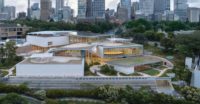Dynamic lighting responding to environmental conditions can enliven an urban space that might otherwise feel deserted or inhospitable. This was one of the goals behind the design for the Willem II Passage—an underpass for pedestrians and cyclists, linking the center of the Dutch city of Tilburg with a redeveloping area, on the other side of a set of railroad tracks, that had been a train-maintenance yard. The pathway, designed by Amsterdambased firms Civic Architects and Bright, has walls clad with handcrafted glass bricks intended as a contemporary reinterpretation of Tilburg’s historic masonry architecture. The new bricks, which come in both folded and flat shapes, are backlit with 30,000 LEDs that change color and intensity depending on the movement of people, the time of day, the seasons, and climatic conditions including wind, temperature, and rain. The illumination sequences, determined with the help of Philips, are based on an algorithm and data collected by sensors, cameras, and a weather station mounted nearby. But since the environmental “inputs” are never the same, the resulting light show never repeats itself, says Ingrid van der Heijden, a Civic partner. The patterns are constantly moving, although only slowly, with low lighting levels and subtle colors during daylight hours. But people traveling through the tunnel at any hour are able to see the lighting respond to their movement, says van der Heijden. “If people understand their influence on their environment they feel safer,” she says.
Next case study: Apartimentum by Kleffel Papay Warncke Architects and Notholt Lighting Design









Post a comment to this article
Report Abusive Comment